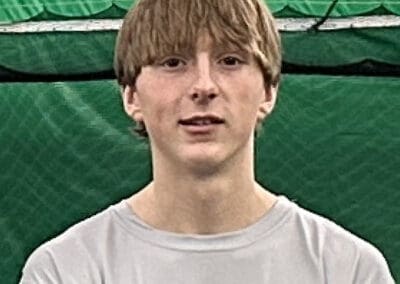Which Stats Tell the Right Story About You?
We just finished our first annual Kicking Combine (the only one in the state, btw) under the 100-yard 90 foot high Hodag Dome in Rhinelander, Wisconsin. Despite the blizzard outside, a few brave souls (and their parents) made the journey to the Dome to attend a mini-camp and Kicking Combine.
Mini-Camp
Coach Farley started the day with a bit of stretching and warm ups to get kickers ready to perform at their best. The physical aspects of kicking are many, but the most crucial, at testing time (and game time) is the mental preparation.
All three phases of kicking (kick-offs, punting and field goals) would be scrutinized during the Combine. Coach Farley shared with participants some great tips for not only getting the most out of their day, but out of their upcoming season, too.
Key Tip #1:
Good kicks and bad kicks can both “mess with your mind”. You have to treat each attempt with a new sense of purpose… not anxiety. Your brain (chemically) doesn’t know the difference between anticipatory excitement and stressful anxiety. It’s up to each individual to convince your brain that you’re excited for the opportunity. That may sound odd, but it’s true. If all that kicking and punting does is create doubt and stress, perhaps you should try another sport. Enjoy the thrill of being the person who helps win the game with a great kick — decide before each kick (in practice and in a game) how you’re going to look at each situation — with dread or with delight?
Key Tip #2:
Consistency is key. You’ve heard it before, but do you actually practice it? A combine is there to show off how far, how high and how big your range can be… but being the person who consistently hits good balls will take you further. The participants in this year’s Combine are all strong kickers and punters. Some of the best in the state of Wisconsin.
Kicking and punting at a focused 90% exertion often works far better than attempting the best kick of your life. It’s almost a certainty that AFTER the testing is over is when you hit your best balls. Why? Because the pressure of the situation is off and you relax, yet keep your form complete by naturally kicking at 90% power.
Now, how to translate that feeling into the time when you actually NEED to hit a good ball… by consistently working at a smoother approach produces dividends. On the rare instances where you have to put “everything” into a kick, you should also feel relaxed. Why? Because you have nothing to lose. You know everything has to go perfectly, a miss is a miss — they don’t give you style points — so give it your all without reservation.
Key Tip #3:
Coach Farley asked each kicker how many field goals they got the chance to kick from last year. The highest number in the group was only 3. Why? Because high school football coaches don’t really understand the kicking game and they “rightfully” don’t trust it. They don’t trust their snapper, line, holder or kicker… and they’re trained to “go-for-it” when close to the goal line. It’s just what they are wired to do.
So here’s how you get at least two more field goal attempts in a season (and likely more). The answer is staring you in the face — YOUR COACH NEEDS TO TRUST YOU.
Aside from treating every practice kick and on every “Special Teams Thursday” practice during the season, as a game day attempt — before the game, in warm ups, find out where the ball needs to be for you to try a field goal (going in either direction). Wisconsin weather is famous for being challenging. You might lose 10 yard going one way vs. another. You should be thinking, “I can make 3-out-of-4 from here”. Like you’d be willing to bet your coach that you could. NOT that you can kick it far enough, BUT that you can make most all of your kicks from that spot.
Every kicker would say that for a PAT… and guess what, your coach puts you in, doesn’t he? So where is the spot that you can go further that he knows you’re “good for it”. But don’t tell him your spot, tell him where the line of scrimmage needs to be to try a field goal. If it were a PAT, you’d tell him the 3 yard line. You might have the leg to go back to 50, but there are few kickers on the planet who can say 3-for-4 from the 50. And if that were true, you’re talking about getting the ball to the 33 yard line. A lot goes through a coach’s head during a game.
Keep it simple, say, “Coach, going into the wind, we SHOULD kick it if we get to the 13 yard line (a 30 yard field goal) and going with the wind, let’s get it to the 20 and we’re good (37 yard field goal).” The coach will know that you can kick it further, but now you’re letting him know that you are realistic about your chances. AND, on the sidelines, you’ll know when he’s ready to put you in. So be prepared to make that distance. With this strategy, you’ll be surprised at how often he’ll call, “FIELD GOAL TEAM!”
VIEW RESULTS ON NORTHWOODSCOMBINE.COM
KICKING COMBINE WINNERS
A Combine is really just a measuring stick you can use from year-to-year to plot your progress. Of course, it’s also a tool to alert recruiter to your capabilities. It’s not a do or die situation, but the self-produced pressure has a way of either getting your best from the day or leaving your best at home. This was new to each of these participants and they all came away with some great lessons learned.
 Kick Offs: DAKOTA STROUD / Jr. / Little Wolf / 449 pts.
Kick Offs: DAKOTA STROUD / Jr. / Little Wolf / 449 pts.
Each participant got five kicks that were filmed and recorded for distance and hangtime. Scores are calculated by taking the distance and adding to hangtime (x 10). So, a 50 yard kick off with a 3.0 hangtime would produce a score of 80 points. This year’s winning kick off winner was Dakota Stroud from Little Wolf High School with a total score of 449 points. His “big ball” was a 57 yard boot with a 4.1 hangtime. A 4.0 hangitme is very difficult to achieve for most high schoolers. Dakota’s kick was close to a “target” high school kick of 60 yards and a 4.0 hangtime (100 points).
 Punting: DAKOTA STROUD / Jr. / Little Wolf / 415 pts.
Punting: DAKOTA STROUD / Jr. / Little Wolf / 415 pts.
Many of our participants struggled on the punting portion. Why? It would seem that more specialists spend time on practicing their kicking than their punting. However, YOU are the logical choice to be the starting punter as well as the kicker. And if not the starter, you are the logical choice to be the back-up. The motion is much the same, but the technique is harder in punting to be consistent. This is an area where most young kickers can really help their teams by developing competency in punting. High school teams desire to advance the ball a net of 30 yards on a punt. That’s a very doable distance, but it takes distance and hangtime to achieve it.
Dakota also won this portion of the Combine with a score of 415 points (using the same scoring system as for kick offs). Dakota connected on a 96 point punt (53 yards with a 4.3 second hangtime). For high schoolers, a “target” punt would be 90 pts (50 yards and 4.0 hangtime).
 Field Goals: ELI SCHUSTER / Jr. / Sturgeon Bay / 424 pts.
Field Goals: ELI SCHUSTER / Jr. / Sturgeon Bay / 424 pts.
At Mike Farley’s Kickers Camp, we do things a little differently than some of the other camps. Most “combines” simply run a Move-back-5-Contest to determine a winner. That’s fine, it puts pressure on and basically, the biggest leg wins the day. That’s not what happens in a game. If you read above, you learned that to get chance to kick in a high school game, you need to really know yourself so that your coach trust’s you.
The competition for field goals works in much the same way. Each kicker warmed up with a 30 yard make. Once done, they can go anywhere on the field for a attempt. You get double the yardard you kick from (a 40 yard FG make is worth 80 pts.), but miss it, and you get ZERO. Now, do you really want to crank it out there from 50, or would a 35 or 40 yarder be the better plan? That’s the challenge that each of our kickers faced and the winner of this portion of the combine was Eli Schuster from Sturgeon Bay High School. Eli’s a lefty with great accuracy and connected on 4 of 5 field goals with his longest at 45. Well played, Eli!
What’s teriffic about this structure is that you can use it during your off-season months as a gauge on your progress. Score your own 5 kicks. Your “target” in high school would be to make 4-out-5 from 40 yards out. That’s a score of 320. If you’re 4-for-4, why not go back and hit a big ball? But if you’re struggling, perhaps coming back in would boost your confidence? It’s a game that any kicker can play with real game like results. You’ll be surprised at how much pressure you’ll feel as you near your best score (or avoiding your worst).
 Combine Specialist: ELI SCHUSTER / Jr. / Sturgeon Bay / 1,154
Combine Specialist: ELI SCHUSTER / Jr. / Sturgeon Bay / 1,154
You’d think that Dakota might have won the day by winning both the Kick Off and Punting Combines, instead Eli’s 4-5 field goals, in connection with his consistent kickoffs and punts made him the overall winner of the Combine. Eli scored a total of 1,154 points, just 18 points more than Cody Vojta from Northland Pines.
Great work, Eli!
We won’t be running another Combine this year… but we will be running the first annual WISCONSIN KICKING & PUNTING CHAMPIONSHIP on July 16th in River Falls, WI, that’s based on this same style of competition!














